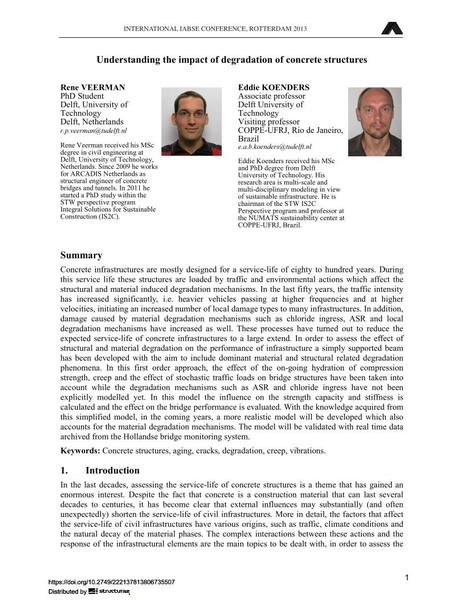Understanding the impact of degradation of concrete structures

|
|
|||||||||||
Détails bibliographiques
| Auteur(s): |
Rene Veerman
Eddie Koenders |
||||
|---|---|---|---|---|---|
| Médium: | papier de conférence | ||||
| Langue(s): | anglais | ||||
| Conférence: | IABSE Conference: Assessment, Upgrading and Refurbishment of Infrastructures, Rotterdam, The Netherlands, 6-8 May 2013 | ||||
| Publié dans: | IABSE Conference, Rotterdam, May 2013 | ||||
|
|||||
| Page(s): | 212-213 | ||||
| Nombre total de pages (du PDF): | 8 | ||||
| Année: | 2013 | ||||
| DOI: | 10.2749/222137813806735507 | ||||
| Abstrait: |
Concrete infrastructures are mostly designed for a service-life of eighty to hundred years. During this service life these structures are loaded by traffic and environmental actions which affect the structural and material induced degradation mechanisms. In the last fifty years, the traffic intensity has increased significantly, i.e. heavier vehicles passing at higher frequencies and at higher velocities, initiating an increased number of local damage types to many infrastructures. In addition, damage caused by material degradation mechanisms such as chloride ingress, ASR and local degradation mechanisms have increased as well. These processes have turned out to reduce the expected service-life of concrete infrastructures to a large extend. In order to assess the effect of structural and material degradation on the performance of infrastructure a simply supported beam has been developed with the aim to include dominant material and structural related degradation phenomena. In this first order approach, the effect of the on-going hydration of compression strength, creep and the effect of stochastic traffic loads on bridge structures have been taken into account while the degradation mechanisms such as ASR and chloride ingress have not been explicitly modelled yet. In this model the influence on the strength capacity and stiffness is calculated and the effect on the bridge performance is evaluated. With the knowledge acquired from this simplified model, in the coming years, a more realistic model will be developed which also accounts for the material degradation mechanisms. The model will be validated with real time data archived from the Hollandse bridge monitoring system. |
||||
